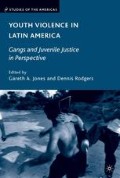Abstract
Among the host of ills afflicting Latin America today—from poverty to political instability—youth has become the primary focus of both blame and concern. One of the most serious of the many problems that disproportionately affect young people is violent crime—marked by a 41 percent rise in homicides that has made Latin America the world’s deadliest region (PAHO 2002). Scholars and policymakers have brought out the causes of the rising crime rates, from poverty to authoritarian legacies. But they have neglected the centrality of youth—as both a group and as a concept—in understanding why crime has turned into a citizen security crisis in Latin America. The policing of youth, this chapter asserts, shows that the region’s response to crime is stuck between its long-standing, centralized, repressive, and often iron fist (mano dura) response on the one hand and, on the other, preventative policing based on addressing crime’s causes through citizen participation and institutional accountability. This impasse leads to contradictory and overly ambitious policies that allow police structures and practices to continue to be based on identifying, separating out, and cracking down on social sectors and areas regarded as inherently criminal—above all, on youth and in the spaces they congregate.
Access this chapter
Tax calculation will be finalised at checkout
Purchases are for personal use only
Preview
Unable to display preview. Download preview PDF.
Bibliography
Arriagada, I. 2001. Seguridad Ciudadana y Violencia en América Latina, paper presented at the XXIII Latin American Studies Association Congress, Washington DC.
Bandeira, A., and J. Bourgois. 2006. Armas de Fuego: ¿Protección? ¿O Riesgo? Guía Práctica, Stockholm: Parliamentary Forum on Small and Light Arms.
Bobea, L. 2003. Economía política de la inseguridad y desafíos a las políticas de seguridad ciudadana en la República Dominicana, in L. Bobea (ed.), Entre el Crimen y el Castigo, Caracas: Nueva Sociedad. pp. 175–228.
Casa Alianza. 2006. Violence in Guatemala: A Channel 4 Documentary, http://www.casa-alianza.org.uk/northsouth/CasaWeb.nsf/CasaNews/Channel, November 2. [accessed November 1, 2007].
Castellanos, J. 2002. El tortuoso camino de la reforma policial, El Heraldo, October 8.
Castillo, S. 2004. Familias Hondureñas Vislumbran Nuevos Horizontes para Sus Hijos, http://www.casapresidencial.hn/reportajes/200104.php, January 20. [accessed November 1, 2007].
CEPAL (Comisión Económica para America Latina). 2003. Panorama Social de América Latina 2001–2002: Elevadas Tasas de Deserción Escolar en América Latina, Santiago: CEPAL.
De Roux, G. 1994. Ciudad y violencia en América Latina, in A. Concha Eastman and F. Carrión (eds.), Ciudad y Violencias en América Latina, Quito: Programa de Gestión Urbana. pp. 25–46.
El Achkar, S. 2007. Reforma policial en Venezuela: Una experiencia en curso, in M. Ungar and D. Arias (eds.), Mejores Prácticas de la Policía Comunitaria en América Latina, unpublished report draft.
Espinal Díaz, E. 2004. La policía nacional de Honduras, Diario Tiempo, January 16.
Fawcett, C. 2003. Los Jóvenes Latinoamericanos en Transición: Un análisis sobre el desempleo juvenil en América Latina y el Caribe, Washington: Inter-American Development Bank.
Gentili, R. A. 1995…. Me Va a Tener Que Acompañar: Una Visión Crítica sobre los Edictos policiales, Buenos Aires: El Naranjo.
Government of Argentina. 2001. Encuesta Permanente de Hogares, Buenos Aires: Instituto Nacional de Estadística y Censos.
Government of Honduras, 2002. Ley de Policía y Convivencia Social, Poder Legislativo, República de Honduras, Tegucigalpa.
Government of the Province of Buenos Aires, 2004. Cuaderno No. 4: Programa de Respuesta Múltiple para la Prevención Comunitaria de la Violencia, La Plata: Ministry of Security.
Grindle, M. S. 2004. The politics of education decentralization in Mexico, in Kaufman, R. Nelson, and J. Nelson (eds.), Crucial Needs, Weak Incentives, Washington: Woodrow Wilson Center Press. pp. 283–314.
Hopenhayn, M. 2004. Elmundo del trabajoy los jóvenes, Jóvenes: Revista de Estudios sobre Juventud, vol. 8, no. 20, pp. 54–73.
Human Rights Commissioner, 2001. Inicia La Discusión del Dictamen de Ley Para Rehabilitar, Boletín Informativo No. 1554, 16 August.
Kelling, G. L., and C. M. Coles. 1996. Fixing Broken Windows, New York: Touchstone.
Kunz, A. 2005. Percepción social de la administración de Justicia, Departamento de Investigación, Área de Sociología Jurídica, Documentos de Trabajo, No 132. Universidad de Belgrano.
PAHO (Pan-American Health Organization). 2002. Violence, a Growing Problem for Public Health, Washington: PAHO.
Pleitez Chávez, R. 2006. Violencia y Criminalidad en El Salvador: Obstáculo para el Desarrollo, San Salvador: Fundación Salvadoreña para el Desarrollo Económico y Social (FUSADES).
Policía Nacional de Ecuador, 2003. Presentation a Cargo del Señor Jefe de Estado Mayor, Quito.
Royal Canadian Mounted Police (RCMP). 2006. Feature Focus: Youth Gangs and Guns, Ottawa: RCMP Strategic Policy and Planning Directorate.
Sanjuan, A. M. 2003. Dinámica de la violencia en Venezuela: Tensiones y desafíos para la consolidación de la democracia, in L. Bobea (ed.), Entre el Crimen y el Castigo, Caracas: Nueva Sociedad.
Small Arms Survey, 2007. Guns and the City, Geneva: Small Arms Survey, http://www.smallarmssurvey.org/ [accessed June 2 2009].
Solís Robles, A. 2004. Analizan situación de las pandillas juveniles en nuestro país, La Prensa Libre, November 12.
UN-Habitat. 2004. The State of the World’s Cities, Nairobi: UNCHS.
UNICJRI (United Nations Interregional Crime and Justice Research Institute). 1995. Criminal Victimization in the Developing World, Publication 55, Rome: United Nations.
USAID. 2005. Reflections on Community-Based Policing Programming in Guatemala, Washington: USAID.
Vieira, C. 2005. Edad de Imputabilidad en Tela de Juicio, Inter Press Service (IPS), August 19.
WHO. 2007. Violence and Injury Prevention and Disability (VIP). Department of Injuries and Violence Prevention of the World Health Organization, Geneva: WHO, http://www.who.int/violence_injury_prevention/en/ [accessed November 1, 2007].
World Bank. 2007. El Desarrollo y la Próxima Generación, Washington: World Bank.
Editor information
Copyright information
© 2009 Gareth A. Jones and Dennis Rodgers
About this chapter
Cite this chapter
Ungar, M. (2009). Policing Youth in Latin America. In: Jones, G.A., Rodgers, D. (eds) Youth Violence in Latin America. Studies of the Americas. Palgrave Macmillan, New York. https://doi.org/10.1057/9780230101333_11
Download citation
DOI: https://doi.org/10.1057/9780230101333_11
Publisher Name: Palgrave Macmillan, New York
Print ISBN: 978-1-349-37017-7
Online ISBN: 978-0-230-10133-3
eBook Packages: Palgrave Social & Cultural Studies CollectionSocial Sciences (R0)

